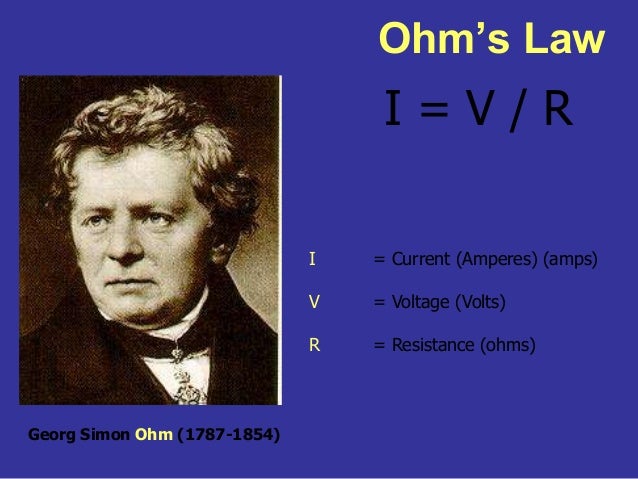Georg Simon Ohm
 |
| SMARTEEE |
Georg Simon Ohm (b. Erlangen, Germany, 16th March 1789, d. Munich, Germany, 6th July 1854) was a
mathematician and a physicist. The SI unit of electrical resistance was named after him as the Ohm. His
father, Johan Wolfgang Ohm, was a master locksmith. Johan Wolfgang married Maria Elizabeth Beck,
daughter of a master tailor. They were a protestant couple. Of their seven children only three survived
childhood: Georg Simon the eldest, Martin the mathematician, and Elizabeth Barbara. Johan Wolfgang gave
his sons a solid education in mathematics, physics, chemistry and the philosophies of Kant and Fichte. Their
mathematical talents were soon recognised by the Erlangen professor Karl Christian Von Langsdorf. Georg
Simon matriculated on the 3rd of May 1805 at the University of Erlangen. He studied 3 semesters there until
his father's displeasure at his supposed overindulgence in dancing, billiards, and ice skating forced him to
withdraw to rural Switzerland.
He began to teach mathematics in September 1806 in Gottstadt. He received his PhD on the 25th of October
1811. Lack of money forced him to seek employment from the German government. But, the best he could
obtain was a post as a teacher of mathematics and physics at a poorly attended 'Realschule' in Bamberg. He
worked there with great dissatisfaction. In 1817, Ohm was offered the position of 'Oberlehrer' of mathematics
and physics at the Jesuit Gymnasium at Cologne. He began his experiments on electricity and magnetism
after 1820. His first scientific paper was published in 1825 in which he sought a relationship between the
decrease in the force exerted by currentcarrying wires and the length of the wires. In April 1826, he published
two important papers on galvanicm electricity. He published his book on Ohm's law, Die Galvanische Kette
Mathematische Bearbeit, in 1827. Sir John Leslie had already provided both theoretical discussion and
experimental confirmation of Ohm's law in a paper written in 1791 and published in 1824, which was not
accepted. Ohm's law was so coldly received that Ohm resigned his post at Cologne. Ohm obtained the
professorship of physics at the Polytechninische Schedule in Nuremberg in 1833. Finally, his work began to be
recognised. In 1841, he was awarded the Copley Medal of the Royal Society of London and was made a
foreign member a year later.
 |
SMARTEEE
|
AndréMarie Ampére
AndréMarie Ampére (b. Lyons, France, 22nd Jan. 1775, d. Marseilles, France, 10th June 1836) was a
mathematician, a chemist, a physicist and a philosopher. The SI unit of electric current was named after him
as the Ampere. His father, JeanJacques, was a merchant. JeanJacques exposed his son to a library and let
him educate himself according to his own tastes. AndréMarie soon discovered and perfected his
mathematical talents. He even learned Latin in order to read the works by Euler and Bernoulli. The great
encyclopédie had the most important influence on him. He was also thoroughly instructed in Catholic faith.
During the French Revolution, his father was guillotined. AndréMarie was unable to bear this shock. For a
year, he retreated, not talking to anyone. During this time, he met Julie Carron who was somewhat older than
he was. Ampére pursued Julie until she consented to marry him. They were wed on the 7th of August 1799
and their son, JeanJacques, was born.the following year. Ampére became the professor of physics and
chemistry at the ÉcoleCentrale of BourgenBresse, where he worked on probability theory. Julie died on the
13th of July 1803 of an illness. Ampére became inconsolable again. He married Jeanne Potot in 1806. After
the birth of their daughter, Albine, they got a divorce.
Between 1820 and 1825, after a series of experiments, Ampére provided factual evidence for his contention
that magnetism was electricity in motion, summarized in his famous 9 points. They describe the law of action
of current carrying wires, and model magnets as having circulating currents in them. Ampére was able to
unify the fields of electricity and magnetism on a basic numeric level. Fresnel helped Ampére improve his
theory by suggesting that there may be currents of electricity around each molecule. Ampére assumed that
the 'electrodynamic molecule' was a molecule of iron that decomposed the aether, that pervaded both space
and matter into the two 'electric fluids.' Ampere's theory of the electrodynamic molecule was not accepted by
everyone. His primary opponent was Michael Faraday, who could not follow the mathematics and did not
accept his theory. Ampére's son fell in love with Mrs. Jeanne Recamier, an entertainer and a great beauty of
the empire. His daughter Albine, married an army officer who turned out to be a drunkard. Following this, after
1827, Ampére's scientific activity declined and he died alone, while on a tour in Marseilles.

